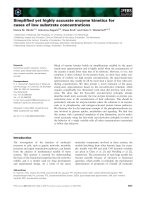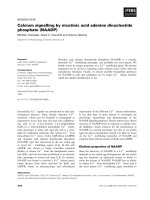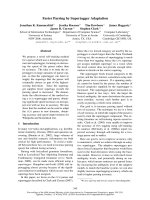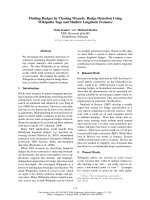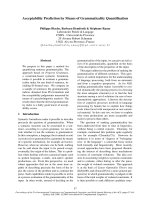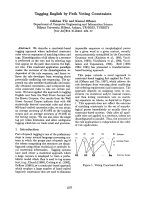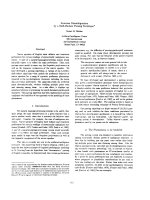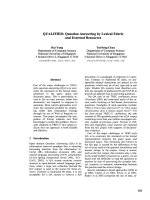Báo cáo khoa học: Substrate recognition by three family 13 yeast a-glucosidases Evaluation of deoxygenated and conformationally biased isomaltosides pptx
Bạn đang xem bản rút gọn của tài liệu. Xem và tải ngay bản đầy đủ của tài liệu tại đây (176.89 KB, 7 trang )
Substrate recognition by three family 13 yeast a-glucosidases
Evaluation of deoxygenated and conformationally biased isomaltosides
Torben P. Frandsen
1,
*, Monica M. Palcic
2
and Birte Svensson
1
1
Department of Chemistry, Carlsberg Laboratory, Copenhagen Valby, Denmark;
2
Department of Chemistry,
University of Alberta, Edmonton, Canada
Important hydrogen bonding interactions between s ubstrate
OH-groups i n yeas t a-glucosidases a nd oligo-1,6-glucosidase
from glycoside hydrolase family 13 have been identi®ed by
measuring the rates of hydrolysis of methyl a-isomaltoside
and its seven monodeoxygenated analogs. The transition -
state stabilization energy, DDGà, contributed by the indi-
vidual OH-groups was calculated from the activities for
the parent and the deoxy analogs, respectively, according
to DDGà ±RT ln[(V
max
/K
m
)
analog
/(V
max
/K
m
)
parent
]. This
analysis of the e nergetics gave DDGà values for all three
enzymes r anging from 16.1 to 24 .0 kJámol
)1
for O H-2¢,-3¢,
-4¢,and-6¢, i.e. t he OH-groups of the nonreducing s ugar ring.
These OH-groups interact with enzyme via charged hydro-
gen bonds. In contrast, OH-2 and -3 of the reducing sugar
contribute to transition-state stabilization, by 5.8 and
4.1 kJámol
)1
, respectively, suggesting that these groups
participate in neutral hydrogen bonds. The OH-4 group is
found to be unimportant in this respect and very little or no
contribution is indicated for all OH-groups of the reducing-
end ring of the two a-glucosidases, probably re¯ecting their
exposure t o bulk solvent. T he stereoch emical course of
hydrolysis by these three members of the retaining family 13
was con®rmed by directly monitoring isomaltose hydrolysis
using
1
H NMR spectroscopy. Kinetic analysis of the
hydrolysis of methyl 6-S-ethyl-a-isomaltoside and its 6-R-
diastereoisomer indicates that a-glucosidase has 200-fold
higher speci®city for the S-isomer. Substrate molecular rec-
ognition by these a-glucosidases are compared to earlier
®ndings for the inverting, exo-acting glucoamylase from
Aspergillus niger and a retaining a-glucosidase of glycoside
hydrolase family 31, respectively.
Keywords: protein-carbohydrate interaction; NMR; glyco-
sidase mechanism; substrate analogs; molecular recognition.
Strong intermolecular hydrogen bonds are very important
in speci®city of enzymes and o ther proteins that metabolize
or bind carbohydrates [1±6]. Substrate analogs such as
deoxygenated sugars, facilitate identi®cation of critical
contacts and enable quanti®cation of the energetics of the
protein±carbohydrate binding at the level of individual
interacting sugar OH-groups and functional atoms or
groups in the protein [4,7±11]. Alternatively, site-speci®c
mutants of a protein are useful in evaluation of speci®c
protein±carbohydrate i nteractions and further insight has
been gained by combining mutant enzymes and analogs
[7,9,10]. The binding energy contributed by substrate
OH-groups has been determined for only a few carbohy-
drate active enzymes. Of these, the starch hydrolase
glucoamylase from Aspe rgillus n iger has been the most
intensively examined [7,9±13].
Three-dimensional structures of protein±carbohydrate
complexes can guide and support protein engineering and
molecular r ecognition experiments. For family 13 glycoside
hydrolases, there are no c rystal structures for a-glucosidases;
however, t he structure o f free Bacillus oligo-1,6-glucosidase
has been solved [14]. Furthermore, only a few a-glucosidases
are produced by heterologous gene expression, which is a
prerequisite for structure±function relationship i nvestiga-
tions by site-directed mutagenesis [15±21]. While the yeast
genome is known and thus the primary structures of its
a-glucosidases, the sequenced strain of Saccharomyces
cerevisiae is not necessarily identical to the baker's yeast
used as a source of enzymes in the present study and
sequences have not been reported for brewer's yeast
enzymes. In view of this limited information, use of synthetic
substrate analogs is particularly attractive for gaining
knowledge of the nature and strength of substrate±
a-glucosidase interactions. Thus using deoxy-analogs key
polar groups in maltose were i denti®ed for high pI barley
a-glucosidase of glycoside hydrolase family 31 to be OH-4¢
and -6¢ with minor contributions for OH-3¢,-2¢,and-3
[13, 22].
Yeast a-glucosidase and oligo-1,6-glucosidase are exo-
acting glycoside hydrolases catalyzing release of a-
D
-glucose
from nonreducing ends of various a-linked substrates. The
enzymes are further subclassi®ed into type I, hydrolysing
heterogeneous substrates like aryl glucosides and sucrose
more ef®ciently than maltose; type II being highly active on
maltose and isomaltose but of low a ctivity toward aryl
glucosides; and type III resembling type II, but hydrolysing
Correspondence to B. Svensson, Department of Chemistry, Carlsberg
Laboratory, DK-2500 Copenhagen Valby, Denmark;
Fax: + 45 33 27 47 08; Tel.: + 45 33 27 53 45;
E-mail:
Enzymes: a-glucosidase (a-
D
-glucoside glucohydrolase, EC 3.2.1.20);
oligo-1,6-glucosidase (dextrin 6-a-glucanohydrolase, EC 3.2.1.10);
glucoamylase (a-
D
-glucan glucohydrolase, EC 3.2.1.3).
*Present address: Pantheco, Bùge Alle
Â
, DK 2970 Hùrsholm Denmark.
Dedication: this paper is de dicated to Prof. Joachim Thiem on the
occasion of his 60
th
birthday.
(Received 12 O ctober 2001, revised 26 November 2001, accepted 30
November 2001)
Eur. J. Biochem. 269, 728±734 (2002) Ó FEBS 2002
di- a nd oligo-saccharides and starch at comparable rates
[23,24]. The sequence classi®es a-glucosidases in glycoside
hydrolase families 13 and 31 [25±27]. Yeast a-glucosidases
and oligo-1,6-glucosidase belong to family 13 and are
of type I that prefers p-nitrophenyl-a-
D
-glucopyranoside
[28].
Glycoside hydrolase family 13 (or Ôthe a-amylase familyÕ)
currently comprises 28 speci®cities of amylolytic and related
enzymes. Several crystal structures of enzyme-inhibitor
complexes highlight active sites created by b ® a segments
in c atalytic (b/a)
8
barrel domains (reviewed in [29±31]).
Because no ligand complex is available of oligo-1,6-
glucosidase, the only structure-determined exo-acting
a-glucosidase [14], s ide-chains partic ipating in s ubstrate
binding and catalysis are solely identi®ed by sequence
comparison. Clearly a-glucosidases lack the sequence motif
in b ® a loop 4 of family 13 [30] containing residues
binding substrate at s ubsite +2 (nomenclature as in [32]) in
a-amylases, cyclodextrin glycosyltransferases, and related
enzymes [30,33±37].
In this study, seven monodeoxygenated isomaltosides are
used to map substrate OH-groups required by yeast
a-glucosidases and oligo-1,6-glucosidase in hydrolysis of
the a-1,6-glucosidic bond. The energy contributed by each
OH-group for transition-state stabilization re¯ects the
strength of a speci®c protein±carbohydrate c ontact a nd
energy pro®les for the a-glucosidases a nd oligo-1,6-glucosi-
dase are compared.
1
H-NMR spectroscopy was used to
con®rm that all enzymes hydrolyse isomaltose with reten-
tion of anomeric con®guration characteristic of family 13
(reviewedin[38]).
The exo-acting glucoamylase s imilarly to the a-glucosid-
ases catalyses the releases of glucose from the nonreducing
ends of substrates, but with inversion of the anomeric
con®guration [39]. While glucoamylase prefers the R-isomer
of isomaltose diastereoisomeric analogs [40], a-glucosidase
in the p resent study selects methyl 6-S-ethyl-a-isomaltoside
in preference to the R-isomer. Molecular recognition of
isomaltosides is more similar for the yeast a-glucosidase and
oligo-1,6-glucosidase of glycoside of hydrolase family 13
when compared to that of glucoamylase of glycoside
hydrolase family 15 or of a type II a-glucosidase from the
retaining glycoside hydrolase family 31 [9,10,40,41].
MATERIALS AND METHODS
Enzymes and substrates
Oligo-1,6-glucosidase from baker's yeast (EC 3.2.1.10;
Lot no. 23H8080), and a-glucosidases from brewer's
(EC 3.2.1.20; Type VI; Lot no. 21F8 105) and b aker's
(EC 3.2.1.20; Type I; Lot no. 122H8000) yeast were
obtained from Sigma. After dissolution in 50 m
M
phosphate
pH 6.8 (a-glucosidases) or 50 m
M
sodium maleate pH 6.8
(oligo-1,6-glucosidase) followed by extensive dialysis at 4 °C
against these buffers, the different enzymes (oligo-1,6-
glucosidase, 30 UámL
)1
; brewer's yeast a-glucosidase,
200 UámL
)1
; baker's yeast a-glucosidase, 61 UámL
)1
)were
used without further puri®cation in the kinetic and stereo-
chemical studies. One unit i s de®ned as t he amount of
enzyme required to liberate 1 lmol of glucose from
p-nitrophenyl a-
D
-glucoside (Sigma) p er min at 30 °C. The
synthesized methyl a-isomaltoside, seven monodeoxy-
genated methyl a-isomaltosides [42], methyl 6-R-C-ethyl-
and methyl 6-S-C-ethyl-a-isomaltoside [41] were generous
gifts of U. S pohr and the late R. U. Lemieux, University of
Alberta, Edmonton, Canada.
Enzyme assays
a-Glucosidase activity was d etermined at 30 °Cin0.1
M
sodium maleate, pH 6.8 (oligo-1,6-glucosidase) or 50 m
M
phosphate, pH 6 .8 (a-glucosidases). Glucose [7,10,40,41]
was a nalysed f or analogs at the reducing end ring (reaction
volume 100 lL), aliquots (15 lL) being transferred at
regular time intervals to microtiter plate wells already
containing quench solution (200 lL1
M
Tris, pH 7.6,
5UámL
)1
glucose oxidase (A. niger), 1 UámL
)1
peroxidase
(horseradish), and 0.21 mgámL
)1
o-dianisidine). Absor-
bances were read at 450 nm after 1 h incubation at
room temperature using a microtiter plate reader (C eres
UV900Hdi, Bio-Tek), and quanti®ed using
D
-glucose as a
standard [22,40]. Deoxygenated glucose analogs were ana-
lysed essentially as described [10,40,41] with substrate
analogs at t he nonreducing e nd sugar ( reaction volume
400 lL) aliquots (100 lL) were transferred to quench buffer
containing 60 UámL
)1
glucose oxidase, 1 UámL
)1
peroxi-
dase, and 0.1 mgámL
)1
o-dianisidine, and the absorbances
were read at 450 nm after 4 h incubation at room
temperature, and quanti®ed using the relevant deoxygenated
D
-glucose as standard. The a-glucosidase catalyzed hydro-
lysis was initiated by a ddition of 0.1±91 U enzyme. The
limited amounts of deoxygenated analogs available allowed
only determination of second-order rate constants, V
max
/K
m
(s
)1
áU
)1
) v
o
/E
o
S
o
,wherev
o
is the initial rate of h ydro-
lysis, S
o
the initial substrate concentration, and E
o
the
amount of enzyme in U. Two S
o
concentrations of around
0.1 ´ K
m
were used to ensure that substrate hydrolysis w as
linear w ith t ime. The increase in activation e nergy due
to substrate d eoxygenation was c alculated by DDGà
±RTln[(V
max
/K
m
)
a
/(V
max
/K
m
)
b
][43],whereareferstoana-
log and b to parent substrate. For the two diastereoisomers,
V
max
and K
m
were determined by ®tting initial rates at eight
different substrate concen trations from 0.1 ´ K
m
to 4 ´ K
m
to the Michealis±Menten equation essentially as described
previously [40].
Reaction stereochemistry
Lyophilized enzymes w ere redissolved in 0.1
M
sodium
phosphate pH 6.8 in D
2
O and the stereochemistry of
isomaltose hydrolys is was determined by
1
HNMRat
310 K using a Bruker AMX-600 spectrometer operated at
600 MHz. After recording the substrate spectrum of
100 m
M
isomaltose (in 600 lL0.1
M
phosphate, pH 6.8,
in D
2
O), enzyme was added (oligo-1,6-glucosidase, 40 U;
baker's, 135 U and brewer's yeast a-glucosidase, 140 U)
and reactions monitored by recording spectra at regular
intervals.
RESULTS AND DISCUSSION
Energetics of deoxy isomaltoside hydrolysis
V
max
/K
m
values for h ydrolysis of m ethyl a-isomaltoside are
comparable for the three enzymes, the a-glucosidases from
Ó FEBS 2002 Substrate recognition in yeast a-glucosidases (Eur. J. Biochem. 269) 729
brewer's and baker's yeast showing 31 and 164% of the
activity of the oligo-1,6-glucosidase, respectively (Table 1).
Furthermore, the activity of the three enzymes was reduced
by roughly the same extent, i.e. 440±3400-, 560±2900-, and
1350±8800-fold by substrate deoxygenation at OH-2¢,-3¢,
-4¢,or-6¢ (Table 1). The losses in activity compared to the
parent substrate for all enzymes were smallest for t he
6¢-deoxy ana log and largest for the 2¢-deoxy analog, while
intermediary losses in activity for 3¢-and4¢-deoxy analogs
did show small variations among the enzymes (Table 1).
For the two a-glucosidases, deoxygenation at the reducing
end ring of the substrate had no effect or a very minor effect,
the activity varying relat ive to the parent substrate b y
factors of 0.84±1.4 a nd 0.42±1.0 for the enzymes f rom
brewer's and baker's yeast, respectively. In contrast, for
oligo-1,6-glucosidase, the deoxy-2, -3, and -4 analogs
showed ninefold, ®vefold, and no reduction in V
max
/K
m
,
respective ly (Ta ble 1).
The DDGà calculated from the V
max
/K
m
values deter-
mined for a given analog and the parent substrate,
respectively, indicated the energy contributed to transition-
state stabilization by corresponding the OH-group. Because
DDGà for the four deoxy-analogs at t he nonreducing sugar
ring, that binds to the enzymes at subsite )1, was in the
range 16.1±24.0 kJámol
)1
for the three enzymes (Table 1),
the r emoval of one of the OH-groups from this ring
dramatically affected substrate hydrolysis. These
OH-groups can therefore be considered key polar groups
and m ost likely interact w ith c harged residues on t he
proteins [44] (Fig. 1 ). At the reducing end ring, however,
DDGà values of 4±6 kJámol
)1
for oligo-1,6-glucosidase
(Table 1) were obtained by replacement of the OH-2
and -3 groups, respectively, suggesting that these
OH-groups participate in neutral hydrogen bonds with the
enzyme (Fig. 1). The OH-4 did not seem important in
substrate binding and hydrolysis.
The three-dimensional structure of oligo-1,6-glucosidase
from Bacillus cereus [14], is currently the only available
structure of a ny type of a-glucosidases. This enzyme has an
N-terminal (b/a)
8
barrel common to glycoside hydrolase
family 13 [30,31], a domain B that protrudes from the barrel
b strand 3, and a C-terminal Greek k ey motif. Moreover
several extra-barrel secondary structure elements occur in
the segments that connect the b strands to the a helices of the
(b/a)
8
barrel fold [ 14]. The catalytic site is located at the
bottom of a cleft between domain B and several of the
b ® a connecting segments [14,30]. The molecular recog-
nition of isomaltose analogs described above indicate very
strong interaction of the nonreducing substrate ring at the
enzyme subsite )1, most probably with charged side chains,
as a major driving force for stabilization o f the enzyme±
substrate transition-state. Several of the side-chains inter-
acting at subsite )1 will belong to the consensus sequence
motifs containing catalytic acids, t ransition-state stabilizing
histidines, and structurally important arginine and aspartate
side chains [30].
While protein±substrate contacts at subsite )1provide
major binding energy, t he distribution and strength of
intermolecular hydrogen bonds involving the aglycon
moiety and subsite +1, as well as subsites beyond subsite
+1 in type III a-glucosidases, exhibit substrate speci®city
variation among the a-glucosidases. The yeast a-glucosid-
ases as reported h ere only show protein±carbohydrate
hydrogen bonding involving subsite )1,andnosugar
OH-groups associated stabilization energy was critical for
accommodation at subsite +1. As shown in Table 2, these
a-glucosidases that do not require hydrogen bonding to the
Table 1. Speci®city constants and DDGà
a
(kJámol
)1
)fora-glucosidase catalyzed hydrolysis of methyl a-isomaltoside and a series of mono-deoxy-
genated analogs.
Oligo-1,6-glucosidase
b
a-glucosidase (brewer's yeast)
c
a-Glucosidase (baker's yeast)
d
V
max
/K
m
(s
)1
áU
)1
) DDGà V
max
/K
m
(s
)1
áU
)1
) DDGà V
max
/K
m
(s
)1
áU
)1
) DDGà
Methyl-a-isomaltoside 1.4 ´ 10
)4
0.8 ´ 10
)5e
± 4.4 ´ 10
)5
2.9 ´ 10
)6
± 2.3 ´ 10
)4
3.2 ´ 10
)6
±
2-Deoxy-methyl-a-isomaltoside 1.6 ´ 10
)5
0.9 ´ 10
)6
5.8 3.7 ´ 10
)5
4.9 ´ 10
)6
0.5 9.7 ´ 10
)5
5.8 ´ 10
)6
2.3
3-Deoxy-methyl-a-isomaltoside 2.9 ´ 10
)5
0.6 ´ 10
)6
4.1 6.0 ´ 10
)5
1.4 ´ 10
)5
)0.8 1.3 ´ 10
)4
1.3 ´ 10
)5
15
4-Deoxy-methyl-a-isomaltoside 1.4 ´ 10
)4
1.1 ´ 10
)5
± 5.7 ´ 10
)5
0.8 ´ 10
)6
)0.7 2.4 ´ 10
)4
2.0 ´ 10
)6
)0.1
2¢-Deoxy-methyl-a-isomaltoside 4.1 ´ 10
)8
5.5 ´ 10
)9
21.5 1.5 ´ 10
)8
1.2 ´ 10
)9
21.2 2.6 ´ 10
)8
3.0 ´ 10
)9
24.0
3¢-Deoxy-methyl-a-isomaltoside 1.1 ´ 10
)7
6.5 ´ 10
)9
18.9 2.7 ´ 10
)8
5.3 ´ 10
)9
19.6 2.7 ´ 10
)8
3.1 ´ 10
)9
23.9
4¢-Deoxy-methyl-a-isomaltoside 1.0 ´ 10
)7
1.1 ´ 10
)8
19.1 1.5 ´ 10
)8
4.4 ´ 10
)10
21.2 3.2 ´ 10
)8
2.8 ´ 10
)9
23.5
6¢-Deoxy-methyl-a-isomaltoside 3.2 ´ 10
)7
2.1 ´ 10
)8
16.1 7.9 ´ 10
)8
4.7 ´ 10
)9
16.7 1.4 ´ 10
)7
1.5 ´ 10
)8
19.6
a
DDGà )RT ln[(V
max
/K
m
)
a
/(V
max
/K
m
)
b
] [43], where a and b refer to analog and parent substrate, respectively;
b
At 30 °C using 0.1
M
sodium maleate, pH 6.8;
c
At 30 °C using 50 m
M
phosphate, pH 6.;
d
At 30 °C using 50 m
M
phosphate, pH 6.8;
e
standard deviation.
Fig. 1. Schematic representation of proposed intermolecular hydrogen
bond interactions between isomaltose and a-glucosidases from baker's
and brewer's yeast and from oligo-1,6-glucosid ase from baker's yeast.
a
, only f or oligo-1,6-glucosidase. Invariant glycoside hydrolase family
13 side chain candidates of interaction with the four nonreducing
substrate ring O H-groups are described in detail in a recent review [30].
730 T. P. Frandsen et al. (Eur. J. Biochem. 269) Ó FEBS 2002
substrate aglycon also have much higher activity for
p-nitrophenyl-a-
D
-glucopyranoside, which lacks hydrogen
bonding groups in the aglycon, than for isomaltose. Due t o
effects on b oth k
cat
and K
m
yeast a-glucosidase thus has
4500-fold lower k
cat
/K
m
for i somaltose than for p-nitrophe-
nyl-a-
D
-glucopyranoside, p-nitrophenol being also a better
leaving group than g lucose. Structural e lements of t he
nonsugar aglycon, however, were not explored. It is
conceivable, however, that such speci®city e xists and could
be investigated using a series of synthetic substrates. In
contrast, the activity of oligo-1,6-glucosidase signi®cantly
depends on aglycon interactions at subsite +1 via neutral
hydrogen bonds with glucose OH-2 and -3 (Table 1). That
such protein interactions with sugar OH-groups are impor-
tant for this enzyme i n contrast to the two a-glucosidases is
also emphasized by the 225-fold difference in the value of
the relative speci®city p-nitrophenyl a-glucoside/isomaltose,
(k
cat
/K
m
)/(k
cat
/K
m
), being 4500 for the brewer's a-g lucosi-
dase (which was chosen because it has the smallest
requirement for OH-groups at subsite +1; see Table 1),
and 20 for oligo-1,6-glucosidase (Table 2). Moreover, the
30-fold more favorable speci®city constant (k
cat
/K
m
)for
isomaltose for the oligo-1,6-glucosidase over the a-glucosi-
dase indeed re¯ects t he gen uine speci®city of the former
enzyme for exo-action on the a-1,6-linkage.
Remarkably, barley a-gluco sidase of glycoside hydrolase
family 31 has a completely different pattern for hydrolysis of
monodeoxy maltoside analogs which indicated strong
protein±substrate interactions at OH-4¢ and -6¢ and weaker,
probably neutral hydrogen-bonds with maltose OH-2¢,-3¢,
and -3 [22]. An even stronger requirement for protein±
isomaltose aglycon interactions was found in isomaltose
hydrolysis by glucoamylase, which depended on enzyme±
substrate transition-state interactions with OH-4 and -3 of
an energy of 16.5 and 8.6 kJámol
)1
, respectively (Table 2;
[7]). Glucoamylase thus has only sixfold lower k
cat
/K
m
for
isomaltose than for p-nitrophenyl-a-
D
-glucopyranoside
(Table 2). The substrate speci®city d ifferences and varia-
tions in aglycon-protein contacts with the two a-glucosid-
ases, the oligo-1,6-glucosidase, and glucoamylase emphasize
that these enzymes display different geometry for the binding
interactions with polar groups of substrates at subsite +1.
This will be investigated further in a study of the diastereo-
isomer speci®city of isomaltoside h ydrolysis (see below).
Catalytic mechanism
One f eature of the d isposition o f substrate relative to
enzyme during the various steps of the catalytic events
directly relates to the mechanism of catalysis being funda-
mentally different for retaining and in verting enzymes [38].
The stereochemistry of isomaltose hydrolysis by yeast oligo-
1,6-glucosidase and a-glucosidases was con®rmed to involve
retention of the substrate anomeric con®guration in the
product. This is illustrated for baker's yeast a-glucosidase
which shows
1
H NMR spectra of isomaltose before
(Fig. 2A) and after (Fig. 2B,C) addition of the enzyme.
Table 2. Kinetic parameters and DDGà for hydrolysis of isomaltose and p-nitrophenyl-a-
D
-glucopyranoside, and mono-deoxy analogs of methyl
a-isomaltoside at binding subsite +1 by a-glucosidases and glucoamylase.
Substrate k
cat
(s
)1
) K
m
(m
M
) k
cat
/K
m
(s
)1
ám
M
)1
) DDGà
a
(kJámol
)1
)
a-Glucosidase (Brewer's yeast)
b
Isomaltose 5.2 34.5 0.15
p-Nitrophenyl-a-
D
-glucopyranoside 135 0.2 677
OH-2 0.5
OH-3 )0.8
OH-4 )0.7
Oligo-1,6-glucosidase
a
Isomaltose 33.3 6.9 4.8
p-Nitrophenyl-a-
D
-glucopyranoside 129 1.3 988
OH-2 5.8
OH-3 4.1
OH-4 ±
Glucoamylase
c
Isomaltose 0.41 19.8 0.021
p-Nitrophenyl-a-
D
-glucopyranoside 0.50 3.7 0.135
OH-2 1.1
OH-3 8.6
OH-4 16.5
a
Data from Table 1;
b
[28];
c
[7,51].
Fig. 2. Hydrolysis of isomaltose by baker's yeast a-glucosidase followed
by
1
HNMR.(A) before addition o f enzyme; (B) 4 min; and (C) 16 h
after addition of enzyme.
Ó FEBS 2002 Substrate recognition in yeast a-glucosidases (Eur. J. Biochem. 269) 731
Comparison of these spectra showed the appearance of a
doublet centered at 5.22 p.p.m. This was assigned to H-1 of
free a-glucose while the resonance at 4.64 p.p.m., which
appeared lat er was assigned to H-1 o f b-glucose which
stemmed from mutarotation of the initially released
a-glucose. The anomer ratio of
D
-glucose (33% a: 67% b)
was deduced from the
1
H NMR spectrum after complete
hydrolysis of isomaltose (Fig. 2C) and falls within the range
normally found for t he equilibrium mixture. The stereo-
chemistry of the products thus con®rmed that the three
a-glucosidases catalyze hydrolysis of isomaltose with reten-
tion of the anomeric con®guration as is characteristic o f
family 13 glycoside hydrolases. Figure 3 shows the widely
accepted double displacement mechanism for retaining
hydrolases, which is believed to occur through oxacarbeni-
um ion transition-states and formation of a covalent
intermediate between the catalytic nucleophile and the C-1
of the substrate glycon [18,30,31,45±49]. Further kinetics
analyses are not feasible due to the limited amounts of
analogs available; we therefore cannot determine the role of
a key polar group in the glycosylation or the deglycosylation
steps in the mechanism (Fig. 3). However, one can conclude
that the discrimination of the diastereoisomer, as this is
associated with the V
max
and not the K
m
, does not happen in
the initial reversible part of substrate complex formation,
but in subsequent steps o f the catalytic m echanism [40].
Recognition of diastereoisomeric isomaltoside
derivatives
Isomaltose is ¯exible due to rotation around the C5±C6
bond. It is possible to block this conformational ¯exibility
by alkylation of C6 (Fig. 4). Previously, methyl 6-R-and
methyl 6-S-methyl-a-isomaltoside were used to determine
the preferred rotational conformer for glycoamylase [40].
Hydrolysis catalyzed by baker's yeast a-glucosidase (this
enzyme was chosen as it has the highest activity of the two
a-glucosidases; see Table 1) was similarly examined using
methyl 6-R-ethyl- and methyl 6-S-ethyl-a-isomaltoside as
the pair of conformationally biased substrate analogs
(Table 3). While methyl 6-S-ethyl-a-isomaltoside was
hydrolyzed with twofold lower V
max
,butthesameK
m
as
isomaltose (Table 3), the 6-R enantiomer was a poor
substr ate V
max
being 150-fold lower and K
m
twofold higher
than for isomaltose (Table 3). Baker's yeast a-glucosidase
thus preferred the 6-S isomer. In contrast, glucoamylase
from A. niger hydrolyzed the 6-R enantiomer with 2 30-fold
higher k
cat
/K
m
compared to the parent i somaltoside, the
difference being essentially in the K
m
and not in the rate of
hydrolysis as for the a-glucosidase [40]. This distinct
preference for one of the two diastereoisomers of the C-6
alkyl isomaltose derivatives re¯ects the fact that one of the
rotamers adopts a conformation with more favorable
Fig. 3. Catalytic mechanism for retaining gly-
coside hydrolases including steps of protonation,
formation of a cov alent intermediate, and
product release, respectively, but not the i nter-
mediate two transition-states (see text for
details and [30,31,39]).
AB
Fig. 4. Structure of the conformationally
biased diastereosisomer substrates methyl 6-R-
ethyl-a-isomaltoside (A) and methyl 6 -S-ethyl-
a-isomaltoside (B).
Table 3. Kinetic parameters for the hydrolysis of conformationally biased isomaltosides.
Substrate V
max
(m
M
á s
)1
áU
)1
) K
m
(m
M
) V
max
/K
m
(s
)1
áU
)1
)
a-Glucosidase from baker's yeast
a
Isomaltose 2.8 ´ 10
)3
9.8 2.8 ´ 10
)4
Methyl 6-S-ethyl-a-isomaltoside 1.6 ´ 10
)3
9.6 1.7 ´ 10
)4
Methyl 6-R-ethyl-a-isomaltoside 1.8 ´ 10
)5
19.4 9.3 ´ 10
)7
Glucoamylase from A. niger
b
k
cat
(s
)1
) K
m
(m
M
) k
cat
/K
m
(s
)1
ám
M
)1
)
Methyl a-isomaltoside 1.04 24.5 0.0042
Methyl 6-S-methyl-a-isomaltoside 1.1 90.0 0.012
Methyl 6-R-methyl-a-isomaltoside 0.68 0.71 0.96
a
At 30 °C, using 50 m
M
phosphate, pH 6.8.
b
[40].
732 T. P. Frandsen et al. (Eur. J. Biochem. 269) Ó FEBS 2002
spatial distribution of the groups that play an important
role in the enzyme recognition. This ®nding stresses the
fundamentally different active site architecture that exists
for the inverting glucoamylase and the retaining a-gluco-
sidases. Glucoamylase, in c ontrast to a-glucosidase, applies
a single d isplacement mechanism and belongs to a different
fold family, glycoside hydrolase 15. The speci®c activities
and substrate af®nities are similar for these retaining and
inverting enzymes, all of which have reasonable capacity i n
the g lucose release from the no nreducing end of disac-
charides and small substrates. However, the a-glucosidase
showed large variation in rate of hydrolysis between the
methyl 6-S-and6-R-ethyl a-isomaltosides, with small
differences in af®nity for the two distereoisomers, whereas
the discrimination b y glucoamylase was associated with the
K
m
[40] and not with the r ate of hydrolysis (Table 3).
CONCLUSION
The enzyme preparations used in the present analysis are
considered valuable representatives of two categories of
yeast a-glucosidases. The study strongly demonstrates the
advantage offered by enzymes with simple speci®city for
application o f substrate analogs in elucidation of the roles
of individual substrate groups or atoms in binding and
catalysis. This is in contrast to other enzymes of the
glycoside hydrolase family 13 catalysing polysacchari de
degradation in an endo-like fashion, for which even model
substrates would typically be rather large and hence
extremely dif®cult, laborious and costly to synthesize. In
addition, the option of s everal function al bin ding m odes in
the active site cleft in these latter enzymes obscures
interpretation using analogs of the impact of speci®c
substrate groups on catalysis. The fact that the enzymes
used in the present study possess a simple substrate
speci®city and belong to the large family 13 representing
28 substrate speci®cities [30] suggests an application of the
present ®ndings, ultimately, for rational protein engineering
of these and other family members with other speci®cities.
Contacts with invariant Arg, His, and Asp residues involved
in charged hydrogen bonds to the glucose ring at subsite )1
in family 13 (reviewed in [30]) are thus proposed to be
responsible for the reported major role of h ydroxyl groups
of this ring in transition-state stabilization. While the
invariant Asp plays a r ole in c atalysis [47] and mutation
leads to i nactivation, the s ingle mutation to Asn of each of
two His interacting at subsite )1 with OH-6 and OH-2 plus
OH-3, in case of b arley a-amylase 1, affected transition-
state stabilization and reduced activity to 5 and 10%,
respectively [50]. Structure guided sequence comparisons, in
contrast, do not yet allow tentative identi®cation of speci®c
residues that are important for the interactions with the
substrate ring at subsite + 1 in the oligo-1,6-glucosidase as
well as for controlling the exo-action at th e level of the
nonreducing end ring at subsite )1ofallthreea-glucosid-
ases included in the present comparison. The ®ndings on
substrate key polar groups and preferred isomaltoside
diasteroisomers, however, will be valuable in future mod-
eling of s ubstrate complexes of the a-glucosidases a nd
related enzymes if the structures become available. The data
may thus guide protein engineering studies that address the
a-1,4 and a-1,6 bond speci®city of these closely related
a-glycosidases.
ACKNOWLEDGEMENTS
Bent O. Petersen is gratefully acknowledged for performing the NMR
spectroscopy experiments and Ulrike Spohr and Raymond U. Le mieux
are t hanked for t he synthetic substrate analogs. Th is work was
supported in part b y funding from the Natural Sciences and
Engineering Research Council of Canada (to M. M. P).
REFERENCES
1. Bourne, Y., van Tilbeurgh, H. & Cambillau, C. (1993) Protein±
carbohydrate interactions. Curr. Opin. Struct. Biol. 3, 681±686.
2. Bundle, D.R. & Young, N.M. (1992) Carbohydrate±protein
interactions in antibodies and lectins. Curr. Opin. Struct. Biol. 2,
666±673.
3. Lemieux, R.U . (1996) H ow water provides the impetus for
molecular recognition in aqueous solution. Acc. Chem. Res. 29,
373±380.
4. Lis, H. & Sharon, N. (1998) Lectins: carbohydrate-speci®c pro-
teins that mediate cellular recognition. Chem. Rev. 98, 637±674.
5. Toone, E.J. (1994) Structure and energetics of protein-carbohy-
drate complexes. Curr. Opin. Struct. Biol. 4, 719±728.
6. Vijayan, M. & Chandra, N. (1999) Lectins. Curr. Opin. Struct.
Biol. 9, 707±714.
7. Frandsen, T.P., Stoer, B.B., Palcic, M.M., Hof, S. & Svensson, B.
(1996) Structure and energetics of the glucoamylase-isomaltose
transition-state complex probed by using modeling and deox y-
genated substrates coupled with site-directed mutagenesis. J. Mol.
Biol. 263, 79±89.
8. Nikrad, P.V., Beierbeck, H. & Lemieux, R.U. (1992) Molecular
recognition X. A novel procedure for the detection of the inter-
molecular hydrogen bonds present in a protein oligosaccharide
complex. Can. J. Chem. 70, 241±253.
9. Sierks, M.R. & Svensson, B. (1992) Kinetic identi®cation of a
hydrogen bonding pair in the glucoamylase/maltose transition
state complex. Prot. Eng. 5, 185±188.
10. Sierks, M.R. & Svensson, B. (2000) Energetic and mechanistic
studies of glucoamylase using molecular rec ognition of maltose
OH groups c oupled with site-directed mutagenesis. Biochemistry
39, 8585±8592.
11. Spohr, U., L e, N., Ling, C.C. & Lemieux, R.U. (2001) The syn-
theses of 6-C-alkyl derivatives of methyl a-isomalt os ide for a study
of the mec hanism of hydrolysis by amyloglucosidase. Can. J.
Chem. 79, 238±255.
12. Bock, K. & Pedersen, H. (1988) Synthesis of 6-(S)deuterium-
labelled derivatives of maltose and isomaltose. Acta Chem. Scand.
Ser. B 42, 190±195.
13. Frandsen, T.P. & Svensson, B. (1998) Plant a-glucosidases of the
glucoside hydrolase fam ily 31. M olecular properties, substrate
speci®city, r eaction mechanism, a nd comparison with family
members of d ierent origin. Plant Mol. Biol. 37, 1±13.
14. Watanabe, K., Hata, Y., Kizaki, H., Katsube, Y. & Suzuki, Y.
(1997) The re®ned structure of Bacillus cereus oligo-1,6-glucosi-
dase at 2.0 A
Ê
resolution: structural characterizat ion of p roline-
substitution sites for protein thermostabilization. J. Mol. Biol. 269,
142±153.
15. Hu
È
lseweh, B., D ahlems, U.M., Dohmen, J., S trasser, A.W.M. &
Hollenberg, C.P. (1997) Characterization of the active site of
Schwanniomyces occidentalis glucoamylase by in vitro mutagenesis.
Eur. J. Biochem. 244, 128±133.
16. Inohara-Ochiai, M., Nakayama, T., Goto, R., Nakao, M., Ueda,
T. & Shibano, Y. (1997) Altering substrate speci®city of Bacillus
sp. SAM1606 a-glucosidase by comparative site-speci®c muta-
genesis. J. Biol. Chem. 272, 1601±1607.
17. Inohara-Ochiai, M., Okada, M., Nakayama, T., Hemmi, H.,
Ueda, T., Iwashita, T., Kan, Y., Shibano, Y., Ashikari, T. &
Nishino, T. (2 000) An active-site m utat ion causes e nh anced
Ó FEBS 2002 Substrate recognition in yeast a-glucosidases (Eur. J. Biochem. 269) 733
reactivity and altered regiospeci®city of transglucosylation cata-
lyzed by t he Bacillus sp. SAM1 606 a-glucosidase. J. Biosci. Bioeng.
89, 431±437.
18. Liiv, L., Parn, P. & Alamae, T. (2001) Cloning of maltase gene
from a methylotrophic yeast, Hansenula polymorpha. Gene 265,
77±85.
19. Nakamura,A.,Nishimura,I.,Yokoyama,A.,Lee,D.G.,Hidaka,M.,
Masaki, H., Kimura, A., Chiba, S. & Uozumi, T. (1997) Cloning
and sequencing o f an a-glucosidase gene from Aspergillus niger
and its expression in Aspergillus nidulans. J. Biotechn 53, 75±84.
20. Okuyama, M., Okuno, A., Shimizu, N., Mori, H., Kimura, A. &
Chiba, S. (2001) Carboxyl group of residue Asp647 as possible
proton do nor i n catalytic reaction o f a-glucosidase from Schizo-
saccharomyces pombe. Eur. J. Biochem. 268, 2270±2280.
21. Takii, Y., D aimon, K. & Suzuki, Y. (1992) Cloning and expression
of a the rmostable e xo-a-1,4-glucosidase gen e from Bacillus
Stearothermophilus ATCC12016 in Escherichia coli. Appl. Micro-
biol. Biotechnol. 38, 243±274.
22. Frandsen, T.P., Olsen, F.L., Mirgo rodskaya, E., Roepstor, P. &
Svensson,B.(2000)HighpIa-glucosidase from barley malt.
Puri®cation, enzymic character ization, and nucleo tide sequence.
Plant Physiol. 123, 275±286.
23. Chiba, S. (1988) a-Glucosidases. In Handbook of Amylases and
Related Enzymes (The Amylase Research Society of Japan, ed.)
pp. 104±105. Pergamon Press, Oxford.
24. Chiba, S. (1997) Molecu lar mechanism in a-glucosidase and glu-
coamylase. Bio sci. Biot ech. Biochem. 61, 1233±1239.
25. Henrissat, B. (1991) A c lassi®cation of glycosyl hydrolases based
on amino acid sequence similarity. Biochem. J. 280, 309±316.
26. Henrissat, B. & Bairoch, A. (1993) New families i n the classi®ca-
tion of glycosyl hyd rolases based on amino acid similarities. Bio-
chem. J. 293, 781±788.
27. Coutinho, P.M. & Henrissat, B. The Carbo hydrate-active Enzyme
Server, available from Y/
28. Yoshikawa, K., Yamamoto, K. & Okada, S. (1994) Classi®cation
of some a-glucosidases and a-xylosidases on the basis of substrate
speci®city. Biosci. Biote chn Biochem . 58, 1392±1398.
29. JanecË ek, S
Ï
. (1997) a-Amylase family: molecular biology and evo-
lution. Prog. Biophys. Mol. Biol. 67, 67±97.
30. MacGregor, E.A., JanecË ek, S
Ï
. & Svensson, B. (2001) Relationship
between structure an d s peci®city i n t he a-amylase family. Biochim.
Biophys. Acta 1546, 1±20.
31. Svensson, B. (1994) Protein engineering in the a-amylase fam ily:
catalytic mechanism, substrate speci®city, and stability. Plant.
Mol. Biol. 25, 141±157.
32. Davies, G.J., Wilson, K.S. & Henrissat, B. (1997) Nomenclature
for sugar-binding subsites in glucosyl hydrolases. Biochem. J. 321,
557±559.
33. Brzozowski, A .M. & Davies, G.J. ( 1997) Structure of the
Aspergillus oryzae a-amylase complexed with the inhibitor acar-
bose at 2.0 A
Ê
resolution. Biochemistry 36 , 10837±10845.
34. Brzozowski, A.M., Lawson, D.M., Turkenberg, J.P., Bisga
Ê
rd-
Frantzen,H.,Svendsen,A.,Borchert,T.V.,Dauter,Z.,Wilson,
K.S. & Davies, G.J. (2000) Biochemistry 39, 9099±9107.
35. Dauter, Z., Dauter, M., Brzozowski, A.M., Christen se n, S.,
Borchert, T.V., Beier, L., Wilson, K.S. & Davies, G.J. (1999)
X-ray structure of Novamyl, the ®ve-domain ÔmaltogenicÕ
a-amylase from Bacillus stearothermophilus: maltose and acarbose
complexes at 1.7 A
Ê
resolution. Biochemistry 38 , 8385±8392.
36. Kadziola, A., Sùgaard, M., Svensson, B. & Haser, R . (1998)
Molecular structure of a barley a-amylase-inhibitor complex:
implications for starch binding and catalysis. J. Mol. Biol. 278,
205±217.
37. Qian, M., H aser, R., Buisson, G., Due
Â
e, E. & Payan, F. (1994) The
active cent er of a mammalian a-amylase. Structure of th e co mplex
of a pancreatic a-amylase with a carbohydrate inhibitor re®ned to
2.2 A
Ê
resolution. Biochemi st ry 33, 6284±6294.
38. Ly, H.D. & Withers, S.G. (1999) Mutagenesis of glycosidases.
Ann. Rev. Biochem. 68 , 487±522.
39. Weill, C.E., Burch, R.J. & van Dyk, J.W. (1954) An a-amylo-
glucosidase that produces b-glucose. Cereal. Chem. 31,150±
158.
40. Palcic, M.M., Skrydstrup, T., Bock, K., Le, N. & Lemieux, R.U.
(1993) Substrate recognition by amyloglucosidase: evaluation of
conformationally biased isomaltosides. Carbohydr. Res. 250,87±
92.
41. Sierks, M.R., Bock, K., Refn, S. & Svensson, B. (1992) Active site
similarities of glucose dehydrogenase, glucose oxidase and gluco-
amylase probed by deoxygenated substrates. Biochemistry 31,
8972±8977.
42. Lemieux, R.U., Spohr, U ., Bach, M., Cameron, D.R., Frandsen,
T.P., Stoer, B.B., Svensson, B. & Palcic, M.M. (1996) Chem ical
mapping of the active site of glucoamylase o f Aspergillus niger.
Can. J. Chem. 74, 319±335.
43. Wilkinson, A.J ., Fersht, A.R., Blow, D.M. & Winther, G. (1983)
Site-directed mutagenesis as a probe of enzyme struc ture and
catalysis: tyrosyl-tRNA synthetase cysteine-35 to glycine-35
mutation. Biochemistry 22, 3581±3586.
44. Fersht, A.R., Shi, J P., K nill-Jones, J., Lowe, D.M., Wilkinson,
A.J., Blow, D.M., Brick, P., Carter, P., Waye, M.M.Y. & Winter,
G. (1985) Hydrogen bonding and biological speci®city analyzed
by protein engineering. Nature 314, 235±238.
45. Davies, G.J., Mackenzie, L., Varrot, A., Dauter, M., Brzozowski,
A.M., Schu
È
lein, M. & Withers, S.G. (1998) Snapshots along an
enzymatic-reaction coordinate ± analysis of a retaining b-glucoside
hydrolase. Biochemistry 37, 11707±11713.
46. McCarter, J.D. & Withers, S.G. (1994) Mechanisms of enzymatic
glycosid e hydro lysi s. Curr. Opin. Struct. Biol. 4, 885±892.
47. Uitdehaag, J.C.M., Mosi, R., Kalk, K.H., van der Veen, B.A.,
Dijkhuizen, L., Withers, S.G. & Dijkstra, B.W. (1999) X-ray
structures along the reaction pathway of cyclodextrin glycosyl-
transferase elucidate catalysis i n the a-amylase family. Nat. Struct.
Biol. 6, 432±436.
48. van der Veen, B., Uitdehaag, J.C.M., Penninga, D., van Alebeek,
G J., Smith, L.M., D ijkstra, B.W. & Dijkhuizen, L . (2000)
Rational design of cyclodextrin glycosyltransferase from Bacillus
circulans strain 251 to increase a-cyclodextrin produ ction. J. Biol.
Chem. 296, 1027±1038.
49. Vocadlo, D.J., Davies, G.J., Laine, R. & Withers, S.G. (2001)
Catalysis by hen egg-white lysozyme p roceeds via a covalent
interm ed iat e. Nature 412, 835±838.
50. Sùgaard, M., Kadziola, A., Haser, R. & Svensson, B. (1993) Site-
directed mutagenesis of histidine 93, aspartic acid 180, glutamic
acid 205, histidine 290, and aspartic acid 291 at the active site and
tryptophan 279 at the raw starch binding site in barley a-amylase
1. J. Biol. Chem. 268, 22480±22484.
51. Frandsen, T.P., Ch ristensen, T., S toe r, B., L ehmbec k, J.,
Dupont, C., Honzatko, R.B. & Svensson, B. (1995) Mutational
analysis of the roles in catalysis and substrate recognition of
arginines 54 and 305, aspartic acid 309, and tryptophan 317
located at subsites 1 and 2 in glucoamylase from Aspergillus niger.
Biochemistry 34, 10162±10169.
734 T. P. Frandsen et al. (Eur. J. Biochem. 269) Ó FEBS 2002
